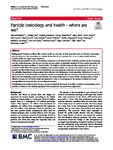Particle toxicology and health - where are we?
| dc.contributor.author | Riediker, M | |
| dc.contributor.author | Zink, D | |
| dc.contributor.author | Kreyling, W | |
| dc.contributor.author | Oberdörster, G | |
| dc.contributor.author | Elder, A | |
| dc.contributor.author | Graham, U | |
| dc.contributor.author | Lynch, I | |
| dc.contributor.author | Duschl, A | |
| dc.contributor.author | Ichihara, G | |
| dc.contributor.author | Ichihara, S | |
| dc.contributor.author | Kobayashi, T | |
| dc.contributor.author | Hisanaga, N | |
| dc.contributor.author | Umezawa, M | |
| dc.contributor.author | Cheng, T-J | |
| dc.contributor.author | Handy, Richard | |
| dc.contributor.author | Gulumian, M | |
| dc.contributor.author | Tinkle, S | |
| dc.contributor.author | Cassee, F | |
| dc.date.accessioned | 2019-05-13T07:39:23Z | |
| dc.date.issued | 2019-12 | |
| dc.identifier.issn | 1743-8977 | |
| dc.identifier.issn | 1743-8977 | |
| dc.identifier.other | 19 | |
| dc.identifier.uri | http://hdl.handle.net/10026.1/13832 | |
| dc.description.abstract |
BACKGROUND: Particles and fibres affect human health as a function of their properties such as chemical composition, size and shape but also depending on complex interactions in an organism that occur at various levels between particle uptake and target organ responses. While particulate pollution is one of the leading contributors to the global burden of disease, particles are also increasingly used for medical purposes. Over the past decades we have gained considerable experience in how particle properties and particle-bio interactions are linked to human health. This insight is useful for improved risk management in the case of unwanted health effects but also for developing novel medical therapies. The concepts that help us better understand particles' and fibres' risks include the fate of particles in the body; exposure, dosimetry and dose-metrics and the 5 Bs: bioavailability, biopersistence, bioprocessing, biomodification and bioclearance of (nano)particles. This includes the role of the biomolecule corona, immunity and systemic responses, non-specific effects in the lungs and other body parts, particle effects and the developing body, and the link from the natural environment to human health. The importance of these different concepts for the human health risk depends not only on the properties of the particles and fibres, but is also strongly influenced by production, use and disposal scenarios. CONCLUSIONS: Lessons learned from the past can prove helpful for the future of the field, notably for understanding novel particles and fibres and for defining appropriate risk management and governance approaches. | |
| dc.format.extent | 19- | |
| dc.format.medium | Electronic | |
| dc.language | en | |
| dc.language.iso | en | |
| dc.publisher | BMC | |
| dc.rights | Attribution-NonCommercial-NoDerivatives 4.0 International | |
| dc.rights | Attribution-NonCommercial-NoDerivatives 4.0 International | |
| dc.rights | Attribution-NonCommercial-NoDerivatives 4.0 International | |
| dc.rights | Attribution-NonCommercial-NoDerivatives 4.0 International | |
| dc.rights | Attribution-NonCommercial-NoDerivatives 4.0 International | |
| dc.rights.uri | http://creativecommons.org/licenses/by-nc-nd/4.0/ | |
| dc.rights.uri | http://creativecommons.org/licenses/by-nc-nd/4.0/ | |
| dc.rights.uri | http://creativecommons.org/licenses/by-nc-nd/4.0/ | |
| dc.rights.uri | http://creativecommons.org/licenses/by-nc-nd/4.0/ | |
| dc.rights.uri | http://creativecommons.org/licenses/by-nc-nd/4.0/ | |
| dc.subject | Air Pollutants | |
| dc.subject | Humans | |
| dc.subject | Inhalation Exposure | |
| dc.subject | Mineral Fibers | |
| dc.subject | Nanoparticles | |
| dc.subject | Particle Size | |
| dc.subject | Particulate Matter | |
| dc.subject | Risk Assessment | |
| dc.subject | Risk Management | |
| dc.subject | Surface Properties | |
| dc.title | Particle toxicology and health - where are we? | |
| dc.type | journal-article | |
| dc.type | Journal Article | |
| dc.type | Review | |
| plymouth.author-url | https://www.webofscience.com/api/gateway?GWVersion=2&SrcApp=PARTNER_APP&SrcAuth=LinksAMR&KeyUT=WOS:000465507900001&DestLinkType=FullRecord&DestApp=ALL_WOS&UsrCustomerID=11bb513d99f797142bcfeffcc58ea008 | |
| plymouth.issue | 1 | |
| plymouth.volume | 16 | |
| plymouth.publication-status | Published | |
| plymouth.journal | Particle and Fibre Toxicology | |
| dc.identifier.doi | 10.1186/s12989-019-0302-8 | |
| plymouth.organisational-group | /Plymouth | |
| plymouth.organisational-group | /Plymouth/Faculty of Science and Engineering | |
| plymouth.organisational-group | /Plymouth/Faculty of Science and Engineering/School of Biological and Marine Sciences | |
| plymouth.organisational-group | /Plymouth/REF 2021 Researchers by UoA | |
| plymouth.organisational-group | /Plymouth/REF 2021 Researchers by UoA/UoA06 Agriculture, Veterinary and Food Science | |
| plymouth.organisational-group | /Plymouth/Research Groups | |
| plymouth.organisational-group | /Plymouth/Research Groups/Marine Institute | |
| plymouth.organisational-group | /Plymouth/Users by role | |
| plymouth.organisational-group | /Plymouth/Users by role/Academics | |
| dc.publisher.place | England | |
| dcterms.dateAccepted | 2019-04-08 | |
| dc.rights.embargodate | 2019-5-29 | |
| dc.identifier.eissn | 1743-8977 | |
| dc.rights.embargoperiod | Not known | |
| rioxxterms.versionofrecord | 10.1186/s12989-019-0302-8 | |
| rioxxterms.licenseref.uri | http://creativecommons.org/licenses/by-nc-nd/4.0/ | |
| rioxxterms.licenseref.startdate | 2019-12 | |
| rioxxterms.type | Journal Article/Review |



